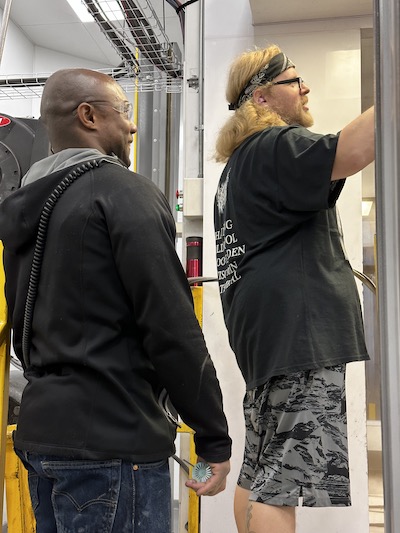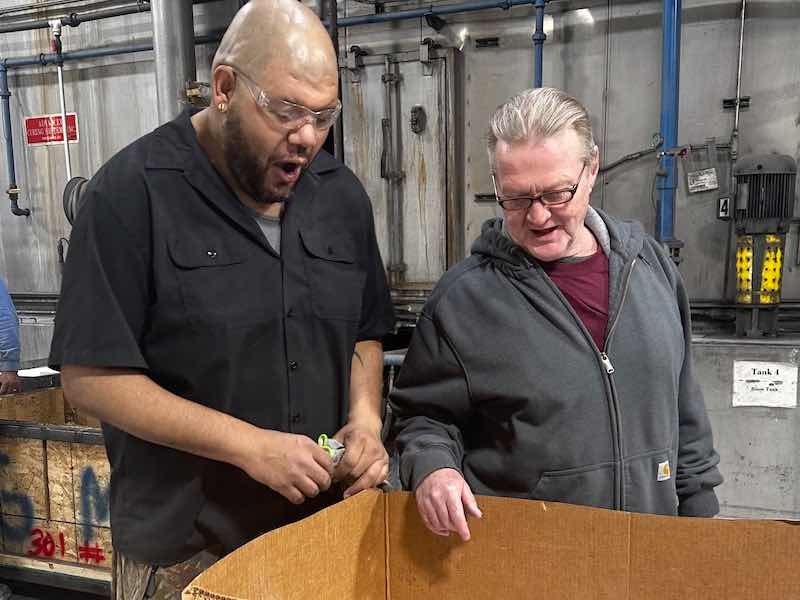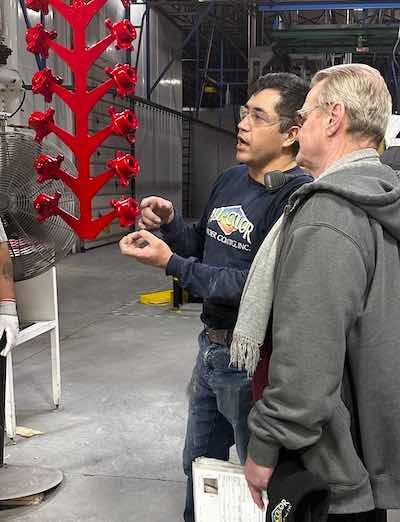During the recent political season, the airways were filled with horrific examples of former inmates returning to a life of violent crime, but politics being what it is, there was little focus on the correctional success stories.
 Dan AndersonWith the labor shortage likely to remain a challenge for employers even if an economic recession results in job losses, business operators who have employed former inmates to meet their workforce needs can attest to their value.
Dan AndersonWith the labor shortage likely to remain a challenge for employers even if an economic recession results in job losses, business operators who have employed former inmates to meet their workforce needs can attest to their value.
Many still don’t get an opportunity to demonstrate that value. A 2018 study by the Prison Policy Initiative quantified the challenges people with criminal records have in the labor market. Among the 5 million formerly incarcerated people (FIP) living in the U.S., its analysis showed they are unemployed at a rate of more than 27%, compared to just over 5% that year for the overall population. The challenge is even greater for people of color, as the Prison Policy Initiative’s data shows that the unemployment rate for formerly incarcerated Black women was about 43%; for formerly incarcerated Black men, the unemployment rate was 35%.
In this look at successful transitions from incarceration to employment, we interviewed All-Color Powder Coating in the Dane County village of Oregon, which benefits from employing former inmates by working with the Wisconsin Department of Corrections to transition inmates to the world of work.
Getting Things Corrected
 Sidney Perry works with another employee at All-Color Powder Coating.All-Color Powder Coating is in the Dane County village of Oregon in Wisconsin. The company works with the Oregon Correctional Center, a minimum-security prison in its own backyard that has a work-release program to help qualified inmates prepare for work upon their release.
Sidney Perry works with another employee at All-Color Powder Coating.All-Color Powder Coating is in the Dane County village of Oregon in Wisconsin. The company works with the Oregon Correctional Center, a minimum-security prison in its own backyard that has a work-release program to help qualified inmates prepare for work upon their release.
Sidney Perry, a former inmate at the center and now a paint lead with All-Color Powder Coating, is one of two former inmates currently employed there. He and Frank Van Wormer, now a second shift supervisor, started working for the powder coating applicator before their release from the center.
“Typically, when they start out, they do start as a regular, standard employee — what we would call a production associate,” says Dan Anderson, general manager for All-Color Powder Coating. “The work is your standard hanging parts, packing parts, painting parts. Sid has actually worked his way up to a lead person in the paint room, and Frank has worked his way up. He is actually our second shift supervisor.”
When they first arrive, former inmates are put through the company orientation just like any other new employee. The orientation includes a training program in all aspects of what they are required to do, but before they even reach that point, there is some vetting for interested employers.
“We actually started the program with the center’s work-release coordinator 15 or 16 years ago,” Anderson recounts. “At that point, we went through a normal interview process with them [inmates]. We actually got the sheets with all their information on their background and everything else, and we would bring them in, sit them down, and do a formal interview with them.”
Inmates Go Through a Process
 Frank Van Wormer, right, is now a second shift supervisor, and started working for the powder coating applicator before his release from the center.Anderson says there are several Dane County companies that use the center’s work-release program.
Frank Van Wormer, right, is now a second shift supervisor, and started working for the powder coating applicator before his release from the center.Anderson says there are several Dane County companies that use the center’s work-release program.
“That’s kind of where we had actually heard of it — from another company around here that we’re very familiar with and was using it at the time,” Anderson recalls. “So, we followed up with them and got in touch with the work coordinator over at the center. That’s how we started off, but right now, it’s my understanding that the center, when they [inmates] are eligible for work release, they have an option of where they can go, and we are one of the companies that are in that pool of companies they can work for.”
As Perry explains, there is a process that inmates go through to reach the point where they can pursue outside work. They must work their way down to secure minimum status, but there is some flexibility for inmates seeking to qualify.
“Some guys, like myself, didn’t have to go through secure minimum because I’ve got an override, and then I had to wait in a 60-day process,” he explains. “During that process, you go before a committee board, and the work coordinator, and they interview you to see if you’re eligible for work release.
“They put you into about 10 jobs to see if you have a good work ethic before they release you into the community,” he adds, “and that’s when the process gets to the point of going to different companies for interviews.”
Perry has reached a supervisory position even though he’s only been with the company since 2021. It wasn’t long before he became a paint lead, a position he could not hold while at the center.
“In all honesty, it’s been good. From the time that I started (while incarcerated), it’s been a good experience. They treated me well and pushed me in the right direction.”
Perry’s career vision simply is to “grow more into the company, take one step at a time, and learn as much as I can, and go as far as I can.”
Assisting with Housing or Transportation Needs
 Once participating inmates are released, All-Color Powder Coating lets them know the company is ready to assist them with housing or transportation needs, but more than anything, they give recently released inmates some breathing room before their post-incarceration employment begins.
Once participating inmates are released, All-Color Powder Coating lets them know the company is ready to assist them with housing or transportation needs, but more than anything, they give recently released inmates some breathing room before their post-incarceration employment begins.
“We’ve always let them know that we are here to help or to assist in any way possible,” Anderson says. “What we’ve typically done with everybody who has gotten released is we give them about two weeks to get their affairs together and do what they need to do before they get back.”
Based on his company’s experience with the work-release program, Anderson would recommend it to other employers who might be reluctant to hire former inmates, but he adds that while it’s been a mostly positive experience, employers shouldn’t expect every new employee to work out. The important thing is to develop them as employees to the best of their ability, just as they would do with any new worker, and not get discouraged from pursuing former inmates as potential workforce contributors if some don’t make a successful transition.
“We’ve had experiences all over the place with it,” Anderson acknowledges. “Right now, we’ve currently got Sid and Frank who are very, very good, but we’ve had people in the past who’ve gotten released, and it’s one of the harder things because when you’re released, you really don’t have what I would say is Big Brother watching you and making you go to work or do those things.
“So, we’ve seen both sides of it, but we’ve had more positive experiences with the guys who have been released and come here,” Anderson adds. “A lot of the guys are from the area and typically want to stay. They are comfortable being here. We treat everybody the same here. There is a little bit of a difference between them and other employees. You don’t have the [health care] insurance, the other benefits, and those types of things while they still are in prison, but when they get released, it’s one of those things that they are shooting for.”
Reviewing Reentry
Department of Corrections Secretary Kevin Carr says any business or group interested in participating in work release, or in partnering on job-preparedness, can contact DOCReentry@wisconsin.gov. As Carr notes, one of DOC’s primary missions is providing opportunities for success, whether that’s through education, job training, or other programs offered to the people in its care.
“A good, family-supporting job can be a major catalyst in someone finding success once they return to their community, and I’m proud of the work this administration has done to help improve job opportunities for people in our care,” he states. “That work includes strengthening partnerships with the state’s tech colleges to provide more training opportunities in high-demand fields, and partnering with the state Department of Workforce Development to open job centers in our facilities, giving the men and women in our care a head start on their job search.
“It also includes the partnerships we continue to nurture with employers across the state through our work-release program,” Carr adds. “Those employers provide a vital resource in helping people successfully reenter the community.”
Visit www.allcolorpowdercoating.com
Joe Vanden Plas is Editorial director of In Business magazine. Please visit www.ibmadison.com



































